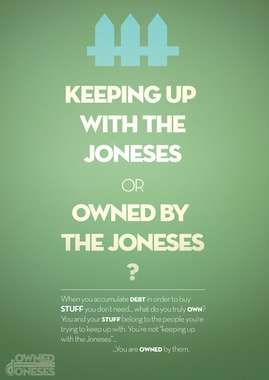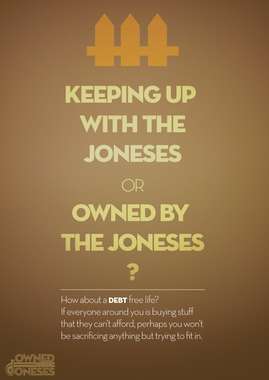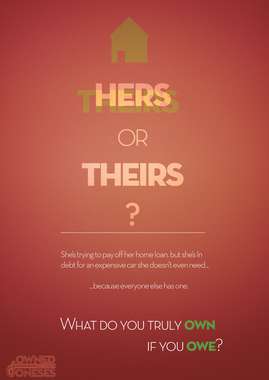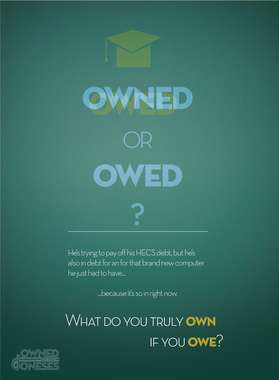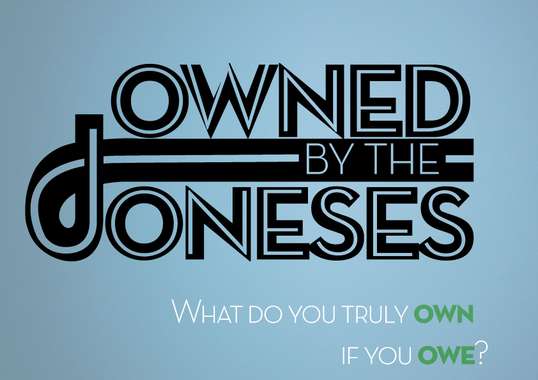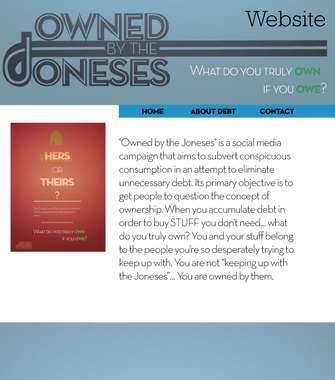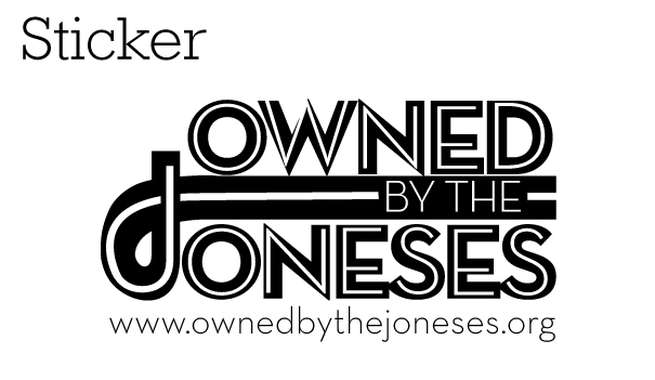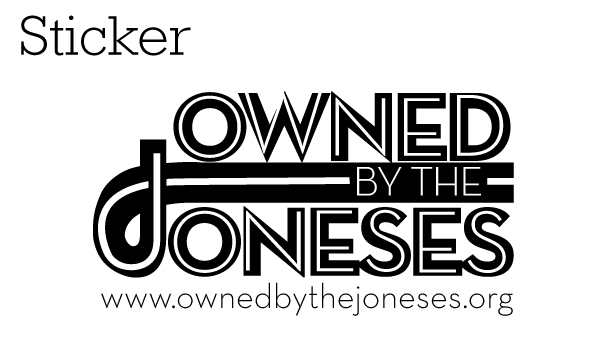Owned by the Joneses
by orangemist
Files
This work has not been commented by curators.
Title
Owned by the Joneses
Headline
What do you own if you owe?
Concept author(s)
John Nicholson
Concept author year(s) of birth
1990
Concept author(s) contribution
I am the only author that contributed to this body of work.
Concept author(s) Country
Australia
Friendly Competition
Competition category
Visual communication practice
Competition subcategory
static
Competition field
academic
Competition subfield
student
Subfield description
Griffith University Queensland College of Art/ Bachelor of Design (Visual Communication Design)
Check out the Debt. 2012 outlines of Memefest Friendly competition.
Description of idea
Describe your idea and concept of your work in relation to the festival outlines:
The problem I would like to address is: Is it possible to live a life free of financial debt? In order to respond to this problem we need to address the reasons why so many people are in financial debt. We feel that it is impossible to live without debt because of the way certain purchase experiences are structured in our society. For expensive items like cars, education and homes we expect that financing with loans and mortgages are the norm.
Personal debt is a direct result of our collective desire to live in excess. This is called conspicuous consumption. We purchase items we don’t truly need because we choose to display our wealth, our status and our personal taste. Even if we can afford these items, it stimulates a culture where everyone is trying to keep up with one another. Eventually people who do not have a disposable income spend money on unnecessary items that are well beyond their means. We are forever trying to “keep up with the Joneses”.
So in order to break this cycle, people need to be encouraged to sacrifice the things they desperately wish they had but can’t afford. This would seem to be an impossible task, because the media, society, capitalism is forever telling us that we can have it all... for the right price. However, if everyone around you is buying things that they can’t afford, perhaps you’re not sacrificing anything but trying to fit in.
What kind of communication approach do you use?
I decided to create a social media campaign called “Owned by the Joneses”. The name is derived from the common English idiom “Keeping up with Joneses” which is used to refer to people’s tendencies to compare themselves to their peers as a standard for social standing or the acquisition of material goods. If you do not “keep up with the Joneses” then you are deemed to be inferior in a society. The "Owned by the Joneses" Campaign aims to subvert conspicuous consumption in an attempt to eliminate unnecessary debt. Its primary objective is to get people to question the concept of basic ownership and to redirect their behaviour. When you purchase something that is tactile- something that you can see and feel, it becomes hard to grasp that what you have acquired isn’t actually yours, because of subsequent debt. When you accumulate debt in order to buy STUFF you don't need, what do you truly own? You and your stuff belong to the people you're so desperately trying to keep up with. You are not “keeping up with the Joneses”... You are owned by them. This is almost like a new-age form of slavery. However, instead of owing our lives to slavers, we owe everything else to our creditors. “Owned by the Joneses” will attempt to re-appropriate the abstract concept of debt through the use of metaphors and language young people can understand. To create a visual response I wanted to make a visual identity for the campaign that is non-threatening, but still emotive enough to gain a response. I wanted to keep a minimal aesthetic so as to not clutter the message of the campaign with visual noise. I also wanted the designs to be youthful in order to relate to the audience. The logotype was inspired by lines and repetition of barcodes- a metaphorical link to consumerism. It’s set in Neutra because of its dynamic and almost severe geometry. It’s bold and had visual impact. The slogan I chose to use is “what do you truly own if you owe” because it’s the most concise way of getting my message across clearly. I also liked that the words OWE and OWN are so similar. It will be easy for the viewer to make a visual connection between the two. For the actual campaign I decided to create a series of posters that are designed to force people to think about what’s truly important to them, and to redirect their behaviour in terms of spending money on things they want just to fit in. Aesthetically they are very minimal, and are primarily typographic. The first poster simply asks “Keeping up with the Joneses or Owned by the Joneses?” In large bold text set in Neutra. Below it fine print reads “When you accumulate debt in order to buy STUFF you don't need... what do you truly own? You and your stuff belong to the people you're trying to keep up with. You’re not “keeping up with the Joneses”...You are owned by them.” This sets the tone for the campaign. It’s a succinct explanation of what the campaign is all about. A stylised picket fence is used as a symbolic device. It represents suburbia and leisure lifestyle as well as drawing from the idiom “the grass is always greener on the other side of the fence”. The second poster poses the same question, but has an alternate fine print and alternate colour scheme. The alternate print reads “How about a debt free life? If everyone around you is buying stuff that they can’t afford, perhaps you won’t be sacrificing anything but trying to fit in.” The third poster makes use of a anecdote. Like the other two posters it asks a question: “Hers or Theirs” then goes on to read “She’s trying to pay off her home loan. but she’s In debt for an expensive car she doesn’t even need... because everyone else has one.” It uses a stylised house as a symbolic device. This forces the viewer to have a larger personal engagement because they see it from someone else’s perspective. I chose the words HERS and THEIRS because they are similar in structure and it’s once again possible to make the connection between the words and the concept of possession. A third poster uses a similar anecdotal device, but instead uses education as the symbolic device, and asks OWNED or OWED. The second campaign item is a website that informs people on the harsh realities of debt. It also aims to inform people on how it is possible to live a life with as little debt as possible. It encourages people not to be ashamed of not conforming to societal standards of what material possessions you ‘have’ to own to be a successful individual. It also has a comment section where users are encouraged to post about things that they have given up in order to reduce their personal debt. The third campaign item is perhaps the most interactive one. I designed stickers with the logo on them. People can stick them on anything they think is unnecessary... anything that is owned by the Joneses to remind themselves of what is truly important. They can also take an activist stance and stick them on any commercial item they find throughput the city that they think stimulates conspicuous consumption. Items like cars, computers, houses, advertisements etc...
What are in your opinion concrete benefits to the society because of your communication?
My campaign will benefit society because it targets young adults who are about to leave university, buy houses and create families of their own. They have reached an age where they have the means to gain an income. This stage is also the most critical in terms of long term planning and saving, which is why debt is such an important topic of discussion with these groups of people.
What did you personally learn from creating your submitted work?
I have learnt that I place to much value on my material possessions instead of focussing on the aspects of my life that really matter. I CAN live a life without debt as long as I'm willing to make the necessary sacrifices.
Why is your work, GOOD communication WORK?
My work is good work because :
It is socially responsible: It will make people question what they truly value. It will encourage people to sacrifice “wanting to fit in” in order to live a relatively debt free life. It will down-play the message that “we can have it all” and promotes realism. This will help to eliminate the “keeping up with the Joneses mentality” that is one of the main reasons for unnecessary debt.
It has quality: It uses a clear visual language that can communicate the consequences of equating needs with desires. It uses a clear visual rhetoric that punches through the visual clutter.
It is Meaningful to me: I have been fortunate enough to live a debt free existence up until now. Debt is an unnecessary burden that I never want to have to deal with, but often I feel that it is inevitability. If I can change this outcome, I will.
Where and how do you intent do implement your work?
I mean to display the posters with close proximity to entities that stimulate debt, such as banks, car dealerships etc... Hopefully these posters will deter prospective consumers from acquiring debt.
Did your intervention had an effect on other Media. If yes, describe the effect? (Has other media reported on it- how? Were you able to change other media with your work- how?)
Not yet :)

